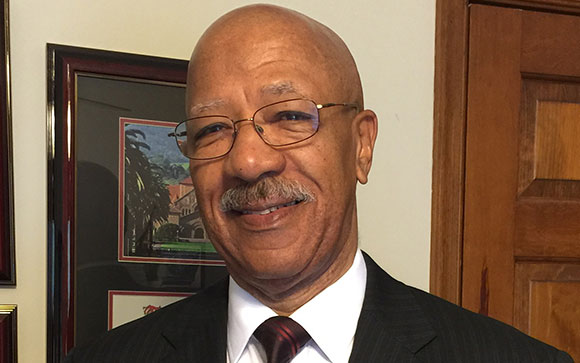March 16, 2022
A New Report Seeks to Understand How and Why Police and Civilian Encounters Turn Deadly
Bowie State Professor Dr. James Hyman Uses Algorithm to Forecast Negative Outcomes

MEDIA CONTACT: David Thompson, dlthompson@bowiestate.edu, 301-860-4311
(BOWIE, Md.) – Each year about 1,000 civilians are killed in the United States by law enforcement officers, leaving families and friends of the victims asking why and searching for answers. Now, a new system developed by James Hyman, assistant professor of public administration at Bowie State University, may be used to help local leaders, the faith community, social justice crusaders, and the police better understand how and why deadly encounters occur.
The Police/Civilian Encounters Framework is an algorithm that logically traces police and civilian behaviors through seven stages of an encounter showing pathways that conform to acceptable policing as opposed to tactics that may lead to negative and sometimes deadly results.
“Civilian fatalities at the hands of police carry an emotional charge that inspires deep feelings as well as deep divisions about how and why they occur,” said Professor Hyman. “Add to this the disproportionate numbers of African American men who die in these incidents and you have an almost immutable split in American public opinion about police and policing. This is why understanding the seven stages of a police/civilian encounter and the ramifications is so important,” he said.
The seven stages of the police/civilian encounter include:
Stage 1 – The Policing Matter – Acknowledges that something has occurred to cause an encounter between a civilian and police officer
Stage 2 – The Police Approach – Examines officer’s initial approach to the civilian
Stage 3 – Civilian Behavior – Focuses on the civilian’s response to the officer
Stage 4 – Situation Status – Examines the status of the encounter in relation to the “Threat Level Assessment”
Stage 5 – Police Action -- Focuses on the police officer’s behavior in response to the “Situation Status”
Stage 6 – Outcome – The result of the police action
Stage 7 – End of the Encounter – The end of the civilian and police interaction
The algorithm uses the stages to construct a comprehensive map of how police/civilian encounters unfold and tracks the behaviors and events that can occur as the encounter progresses. How an encounter unfolds is dependent upon behaviors that are driven by the level of understanding, perceptions, and expectations that police and civilians have of each other.
“The Police/Civilian Encounters Framework is being put forward as an aid to policing officials, criminal justice authorities, and civilian advocates,” said Professor Hyman. “It differs from current policing models because it offers a more micro-level, systematic look at how encounters between police and individual citizens unfold, thus increasing the transparency of these interactions. This will enable law enforcement officials and the general public to examine more closely how an encounter can go wrong and lead to needless injury and death,” he said.
Dr. Hyman’s report uses traffic stops as the context for the analysis. Data indicates that of the 254 million people over the age of 16 in the United States in 2015, 21.6%, or 53.5 million of them had encounters with police officers. Slightly more than half (10.8%) of those encounters were initiated by police on matters they suspected or perceived as unlawful, while the other half (10.7%) were initiated by civilians who were reporting incidents to law enforcement.
The majority of police-initiated encounters, or roughly 80%, were the result of traffic stops. By extrapolation, traffic stops accounted for 40% of all such encounters making them the primary cause of encounters between police and civilians that year. In addition, traffic stops are a suitable reference because they can happen to anyone regardless of race, gender, socioeconomic status or any other demographic and they have, on occasion, turned deadly.
The report suggests that the algorithm has the potential to assist with investigations where charges of police misconduct are alleged. It more clearly establishes the boundary between police behaviors deserving additional scrutiny and those that may require discipline and/or prosecution. But it can also be used to improve policing practice by helping identify areas of needed research that can inform police training and citizen education. If used as an instrument of policy, the algorithm can streamline law enforcement investigations and provide transparency into the justice system.
“What is particularly helpful about this framework is that it provides specific language to describe the police encounters we’re seeing in our day to day lives,” said Marybeth Gasman, executive director of the Samuel DeWitt Proctor Institute for Leadership & Justice. “The author provides specific benchmarks that can be used to gauge whether certain actions made by either the officer(s) or the civilian(s) are justifiable, and identifies where exactly an encounter went wrong.”
“In today’s increasingly divided political environment, it appears that Americans are finding more and more issues over which to polarize,” said Professor Hyman. “For the sake of preserving order in our society and safety in our communities, policing should not be one of them. Reconciling our opinions requires more visibility into police/civilian encounters, increasing transparency so that all audiences, particularly African Americans who feel aggrieved, can make informed conclusions about these events and whether or not they represent miscarriages of justice,” he said.
The Police/Civilian Encounters report was funded by a grant from the Samuel DeWitt Proctor Institute at Rutgers University. You may access the report here.
###
About Bowie State University
Bowie State University (BSU) is an important higher education access portal for qualified persons from diverse academic and socioeconomic backgrounds, seeking a high-quality and affordable public comprehensive university. The university places special emphasis on the science, technology, cybersecurity, teacher education, business, and nursing disciplines within the context of a liberal arts education. For more information about BSU, visit bowiestate.edu.
